#Fish Iconography
Explore tagged Tumblr posts
Text
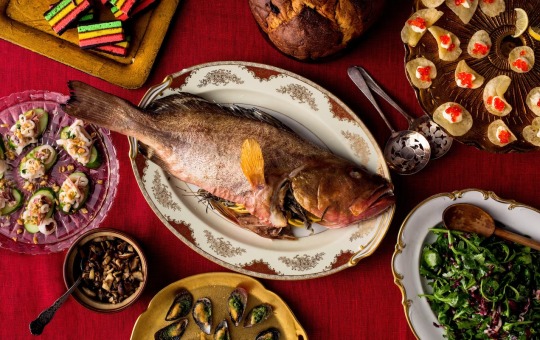
There are as many variations on the Feast of the Seven Fishes as there are participants. Menus often have changed drastically since the turn of the 19th century, but the object of cultivating family and heritage remains. Photograph By Andrew Scrivani, The New York Times/Redux
What is the Feast of the Seven Fishes?
This Christmas Eve seafood feast is an Italian American tradition that dates back to an immigration wave in the 1900s.
— By Allie Yang | Wednesday July 26, 2023
An episode aptly titled “Fishes” from Hulu’s breakout series The Bear explores complex family dynamics against the backdrop of an Italian American tradition: The Feast of the Seven Fishes.
Throughout the Season 2 episode, no one seems able to adequately explain its history. Characters attempt to contextualize the origins of the meal, with explanations ranging from “it’s tradition… the seven fishes” to “it’s a chance to be together and to take care of each other and to eat together, and there’s seven fishes, which means you have to make seven entirely different dishes, seven entirely different ways.” A discerning viewer will note the circular reasoning.
By episode’s end, the audience might leave with unanswered questions. Namely: What is the Feast of the Seven Fishes, and where did it originate?
Italian Origins
The Feast of the Seven Fishes is a dear tradition to many Italian Americans who enjoy (at least) seven different seafood dishes on Christmas Eve. You might find labor-intensive preparations of baccalà (salted cod fish), calamari fritti with lemon and marinara sauce, stuffed escarole, fried smelt, scungilli (conch) in a chilled seafood salad, and stuffed clams oreganata.
You won’t hear about “festa dei sette pesci” in Italy though, says Michael Di Giovine, professor of anthropology at West Chester University of Pennsylvania and author of Edible Identities. In Italy, the holiday is simply “la vigilia,” “the eve” of Christmas. And fish is really only eaten in Southern Italy on the holiday.
This is because the feast has evolved to be uniquely Italian American over the past hundred years.
At the turn of the 19th century, Italian immigration exploded, numbering 300,000 in the 1880s, jumping to 2 million by 1900. As Italian immigrants moved away from extended family and their children grew and married Americans, the Feast of the Seven Fishes evolved from la vigilia into something much more extravagant. Di Giovine says the feast was a way to differentiate themselves, a marker of identity. It also became a tradition to strengthen bonds with both family present and ancestors past.
Today, there are as many interpretations of the feast as there are participants, Di Giovine says.
Why Fish—And Why Are There Seven?
A vast majority of Italian immigrants to the United States were from rural Southern Italy at the turn of the 19th century. When the country was unified in 1861, they had new freedoms from a weakened aristocracy. They came to America because there were jobs (from building railroads to skyscrapers) and mobility. Friends and family found success and brought their loved ones to the U.S.
Some say fish was chosen for the Feast because it was plentiful for impoverished families in Southern Italy. Others say the sea represented Italian Americans’ connection between their old and new homes. Still others say fish was served simply because it’s seen as an aphrodisiac.
Though many families no longer associate the feast with Catholic tradition, there’s likely a religious explanation for the seafood. The first Christians used fish iconography to denote membership. In one biblical tale, Jesus procures a large catch of fish, and promises his disciples an abundance of followers when he commands them to be “fishers of men.” To this day, the Pope wears the “ring of the fisherman.”
Seven is also a holy figure: it’s the number of sacraments and deadly sins. In the Bible, Jesus miraculously feeds a crowd of people with seven loaves and fishes. “Consumed in multiples of seven, then, fish may be a deeply ingrained symbol of sanctifying and revivifying a plentiful group, and of promising continued abundance for posterity,” Di Giovine writes in a 2010 paper on the subject.
Tradition is Always Evolving
Italian culture is very regional, with small communities specializing in certain foods. North and Central Italy didn’t eat fish on Christmas Eve. The rush of immigrants at the turn of the 19th century were from the South, which has Spanish influences on the language and food. Fish, olive oil, vinegar, beans, tomatoes and fried foods like pizza fritta (pizza pockets) and zeppoles (donuts) are foods from the Italian South (notably not pasta).
In the 1900s, anti-Italian sentiment was high and Italians from different regions were lumped together by outsiders. Eventually, traditions also became melded together to produce the current Americanized image of pan-Italian food that ranges from pizza to cannoli, which are both regional in Italy.
After World War II, Italians were accepted members of American society. They moved (with everyone else) to the suburbs, their kids went to school with those from other backgrounds, and TV was popularized, homogenizing the population’s taste. Language and religion are lost quickly in this situation, Di Giovine says, and food could be a way to separate yourself that you could choose when to use.
Writer and director Robert Tinnell made a comic in 2004 about his experience with the Feast of the Seven Fishes, which he later made into a 2019 movie. Growing up in North Central West Virginia, he fondly remembers his great grandmother organizing the Feast. After she died, his grandfather and other men in the family took over. That particular masculine domesticity is something that the first Italian immigrants would have also performed out of necessity: men came to America first, without their wives and daughters.
However, knowledge about where to shop, when to prepare, how to cook, the history behind the meal, and family traditions quickly became the responsibility of mothers to pass down to their daughters, Di Giovine says. They are also likely the ones who have the ultimate say in making changes to recipes. Over time, families often tweak the menu to make things easier, cheaper, more abundant, and more accommodating of dietary restrictions.
“We’re not precious. I do a couple things that would have been on her table,” Tinnell says, referring to his great grandmother. “But then my wife loves seeking out new things. A few years ago, we picked up oysters and set them up outside over open flames; we roasted them in the shells. My family never did that. But I wouldn't trade the time that I spend with my father-in-law, my brothers, to all the kids—it's a new thing. And that's what's important here… that togetherness and that shared experience.”
#National Geographic#Culture#History#Christmas Eve#Seafood Feast#Italian 🇮🇹 -American🇺🇸#Fishes#Tradition#Michael Di Giovine#West Chester University of Pennsylvania#La Vigilia (The Eve)#Catholic Tradition#Southern Italy 🇮🇹#Fish Iconography#Spanish 🇪🇸 Influences#Pizza Fritta (Pizza Pockets) and Zeppoles (Donuts)#Cannoli#American Society#Robert Tinnell#North Central West Virginia
5 notes
·
View notes
Text
#Woodensday :

Dance Mask Yup'ik artist, Alaska, c. 1900 Wood, pigment, vegetal fiber The Metropolitan Museum of Art, New York L.2018.35.100 “The collective life force of all creatures past, present, and future is embodied in the depictions of #animals on this dance mask. Its bentwood hoop represents the border of the universe and encloses images of a humanoid spirit face, a #seal, a #fish, and a #loon - all within the grasp of a large human hand. A dancer would wear the mask in a winter ceremony honoring the animals who gave their lives during the year and ensuring their return in the coming season.”
#animals in art#birds in art#19th century art#20th century art#bird#loon#seal#fish#mask#dance mask#Indigenous art#Native American art#Yup’ik art#Metropolitan Museum of Art New York#museum visit#animal iconography
65 notes
·
View notes
Text

leeches, baby!
7 notes
·
View notes
Text


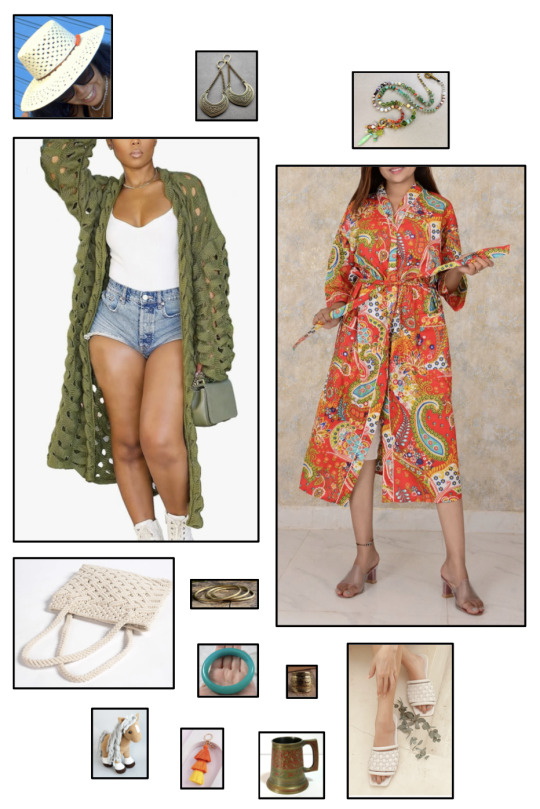

With these, 50 Aesthetics complete! These are Adventurecore, Spacecore, Bohemian, and Junglecore.
#aesthetics#Adventurecore is kind of vague and confusing in the sense that it sounds a lot like Gorpcore#'You want to look like you can just go on an adventure at any time'#'Very practical and comfortable'#I thought about it a bit and decided to figure out a way to differentiate#Decided to go for the vibe of a modern fairy tale protagonist who has to keep to the path and deal with random talking animals#You could do a stroll through the woods in this maybe or do some casual fishing#I went for the angle that the person was unexpectedly plunged into a weird situation and isn't perfectly prepared lol#Monochrome is because I think it adds a bit to the out-of-place vibe + I think it's stylish#Spacecore I tried very hard to set apart from Aliencore as a whole plush notwithstanding#Bohemian I wanted to make another/more obvious orange design and this aesthetic felt the most distinct from others I've done already#It was the last one I picked and I struggled a bit with what I'd do there#Considered Arcadecore and Old Money but Arcadecore felt more similar to others I'd done#While Old Money felt like a less interesting version of Academias or Nautical#It's basically preppy with a few extra steps and kind of vague guidelines#Junglecore technically has two possible angles that are not similar at all lol#One was 'you are a Western explorer in khakis and a safari hat' while the other was 'you're covered in jungle imagery/iconography'#Weirdly most people seemed to be doing the first angle while I haven't encountered the second much#I wanted to do a deep green design and I love animals a lot so went that route#And it was fun making a clear separation from tropical tbh#I considered Coconut Girl but have a lot of ocean looks already and I wasn't sure if it would stand out or be versatile enough#There are over 300 aesthetics so definitely didn't do them all haha and there might be some that are very distinct that I wasn't aware of#If you have reached this point gold star for commitment! ;P
2 notes
·
View notes
Text
Hate when people don't put the artist in the tags of their *aesthetic* posts so I did the research myself.
Artist: Francesco Queirolo
Pieces: Il Disinganno, Pudicizia , cristo velato
Place: Cappella Sansevero (Neapoli)




#You are just lucky I knew the artist because I had the cappella sansevero and it's iconography in my art history studies#It's a most fascinating interpretation of the values and sins iconography#The man getting rid of the fishing net means he is freeing himself of the net of sins and lies
548 notes
·
View notes
Text
btw my second art history paper got a good grade n compliments abt how thorough my research was/how good my sources were

#quiet emily#he said I could expand some more on fish iconography in Korean art as well as celadon glaze imports in that era#but professor approved so WE BALL
1 note
·
View note
Text
Romanticism
k.bakugo x fem!reader | fluff | art museum date | 1.2k words



You don’t know how you were able to convince your boyfriend to go to the art museum with you. He wasn’t one for dates where he had to stand and stare at something (you discovered this during a trip to the aquarium, where Katsuki’s usual scowl felt much more intense as he pointed at every ugly fish he could find and claimed they looked like Kirishima) but he did enjoy the closeness of being attached to you; whether it was holding your hand or an arm around your waist, he was glad to be spending at least some kind of time with you.
Katsuki had dressed up for the date, too. Mostly under your advision. He only usually dressed up if he knew the date location would be fancier, but you insisted on the nice outfits ‘for once’ as you put it. Something about looking nice for pictures, or whatever. He couldn’t really hear you over the steaming noise when you were ironing his slacks.
You tugged him by the hand across the glossy flooring, a large smile on your face as you looked at and yapped about different artworks. Katsuki, on the other hand, had no clue what you were ranting about. He understood close to none of it. Baroque? Renaissance? They both looked the same to him. Even when you explained they were not and why, he stared at you with his brows knit together.
They both had religious…what's the word you used….? Iconography? Yes, religious iconography! He knew they both had religious themes but if you were two put two pieces next to each other and ask him to classify them, he’d glare at you to take his place. He wouldn’t want to disappoint you, after all.
The two of you stood in a large room, staring up at a painting of a horse. Katuski didn’t understand what drew you to this painting in particular. It’s just a horse, nothing special! He saw several other ones just in that room that seemed much more interesting to him.
“Ah, romanticism. One of my favourite styles. Look how detailed the mane is,” your gaze was soft as it was focused on the painting, your hand tightly holding onto his. Your interlocked fingers caused your nails, the ones he ever so diligently paid for, to gently dig into the back of his hand.
“Romanticism? What the fuck is romantic about this shit? It’s a fucking horse!” Katsuki huffed loudly, his agitated voice echoing in the room.
“Romanticism and romance aren't the same, Kats…” you gently patted his arm to calm him.
“Oh? Do enlighten me, then. What is so different about them, hm?”
You rolled your eyes, turning to face him.
“Romanticism deals with romanticizing the natural world,” you explained calmly. “Nature was a source of beauty and inspiration. Pieces, whether paintings, writings, or music, could lead to a better understanding of our natural world.”
God you looked so proud of yourself, Katuski couldn’t even be mad. “Ah, I see…”
“Mhm! Think of like…Mary Shelley’s Frankenstein. That’s a good example I think you’d know.”
“I didn’t read that shit.” Katsuki said it with such a straight face it was nearly comical. You blinked slowly, turning back to the painting.
“Oh…”
“Yeah, oh.”
“...you should read it some time. I have three copies at home that you can choose from-”
“Three?” the blond scoffed. Who the hell keeps three copies of the same novel?
“Yeah. Three,” you shifted on your feet slightly. “One is an annotated copy for ‘creator’s of all kinds,’ one is a regular copy that I’ve annotated, and the last one had a pretty cover.”
“Nerd.
“Your nerd,” you stuck your tongue out at him.
“Yeah, unfortunately…” Katsuki grumbled, pulling you along. The sooner you covered the different exhibits, the faster he could leave and go stuff his face at the local cafe. He really was craving a pain au chocolat right now, but it had to wait.
Katsuki hated to admit it, but he was actually having fun. Maybe it was because he was with you, or your constant yapping, but it genuinely wasn’t as bad as he thought it would be. He sneaked in a few cute photos of you, too. That was surely a bonus, especially since he knew you’d be happy if he posted them to his Instagram story without being told to. He did love showing off his girl, after all.
His favourite exhibit had to be the Ancient Greek exhibit. Maybe it was the way you were flapping your hands excitedly over the black-figure pottery (he really liked how they depicted many of the Gods and Goddesses on them) or how you would giggle at the male nudes you said were called kouros with him.
Katsuki found the Egyptian exhibit to be a favourite as well, his gaze fully focused on the different sarcophagi on display. He tilted his head slightly in curiosity. Some of the heads were sculpted, while others were more realistic painted portraits on what he thought looked like wood paneling.
“Huh, I wonder why they changed it…” he mumbled under her breath.
“Roman invasion.”
“What?” he turned to you, face scrunching up.
“Yeah, Romans. Egyptians changed their burial practices after the Romans invaded. Things became simpler and closer to Hellenistic influence. And the painted faces were done similarly to Roman art, like many of the religious pieces,” you explained to him, using your finger on the glass to point out the differences. “Greco-Roman influence.”
Katsuki turned to you, eyes squinted as his grip on your hand tightened. “How the hell do you know all of this, pretty? We’ve been running around all day and your mouth never stopped spitting information out at me.”
“Very disappointed you don’t know by now, Kats…” you pouted, raking her nails of your free hand up and down his arm.
“The hell you mean?”
“I took art history classes my first year of university, dummy. Two, actually. It’s how I met Kyoka, remember? And if it wasn’t for that…” you trailed off in hope that it would finally click for him.
“Oh, right.” Katuski swept under his nose with the back of his hand. “We wouldn’t have met. Or have you yapping in my ear all day.”
“You’re acting like you hate it. Admit it, you enjoyed our date.”
“Yeah, I did.” A small huff, paired with an even smaller smile. “I think I enjoyed it because of your yapping.”
“You’re so sweet, Katuski…” you kissed his cheek with a grin on your face. He actually enjoyed the date? That was super totally awesome! Sometimes you were scared he would get bored or annoyed, so you must have done a good job with your limited planning done.
“Whatever. Can we go to the gift shop and see if they have replicas of those organ jar things? The ones with the fuck-ass looking heads on them.”
“Canopic jars…?” you guessed, earning a nod from him. “Of course, let’s go see.”
Oh, you totally needed to drag him to museums more often.
You wouldn’t have to wait long though for the next opportunity. Just 2 weeks later, he stormed into the bathroom as you finished brushing your teeth, nearly choking on spit as he magically appeared behind you in the mirror like a ghost.
“There’s a cool art museum an hour away by train. Get dressed, we’re leaving in 20 minutes,” Katsuki spoke coolly before making his way out of the bathroom. Perhaps the day’s plans could wait, for fate had scheduled yet another free-yapping session your boyfriend wouldn’t be able to back out of now.

© property of cherrieshalo 2025 - please do not steal or copy my work to post elsewhere
#my hero academy fanfiction#my hero acedamia#boko no hero academia#mha#bnha#mha drabbles#mha x reader#bnha x reader#katsuki bakugo mha#katsuki bakugo x reader#katsuki x y/n#bakugo x reader#bakugo x y/n#bakugo x you#mha fluff#fluff#fluff fic
129 notes
·
View notes
Text
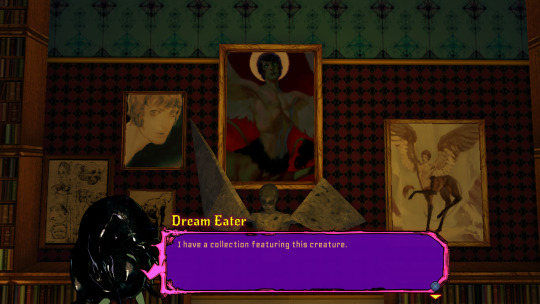
Love iconography in Sorry We're Closed (2024)
As the Angel of Love in this game is represented by a horse-chimera, there was a lot of care put into using horses to symbolize love & relationships. There's the obvious theme of Dream Eater plastering his realm with paintings, statues, and artifacts about Chamuel and other random places like the crypt using his visage too, but I'm mostly gonna talk about something a bit more abstract.
Sorry We're Closed uses hearts as its primary symbolism for love; but it also uses a less mainstream visual motif to show us how it matters to the characters. Horse. :)

To start with, each episode of Dying Petals starts out with a shot of a horse painting, before zooming out to bring in the characters.

Shots of the characters talking will usually be accompanied by one or two paintings. This is where we first see horses associated with relationships.

[There are TWO SEPERATE paintings behind them, yknow, just in case you don't notice the first.]
You might know that the story represents Michelle's love life, (quite literally as Epiphany is played by her actual ex; the story mimics their conflict and break up) but this room also becomes the place where Michelle solidifies her destiny, whether she chooses new love, her ex, or something else.
Also, notice how the painting behind Canary is much bigger than the one behind Epiphany. This is still true when accounting for perspective.
Although the biggest (and brightest) horse painting is off-screen.
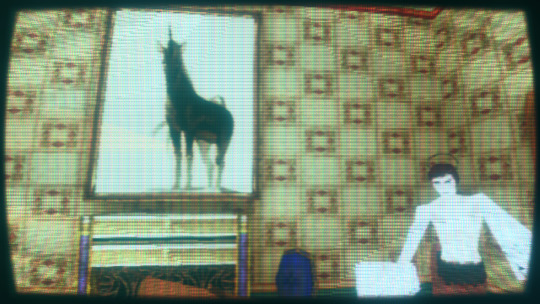
You can see it behind Chamuel on the final day, next to his door that allows you to choose love.
The Carousel.
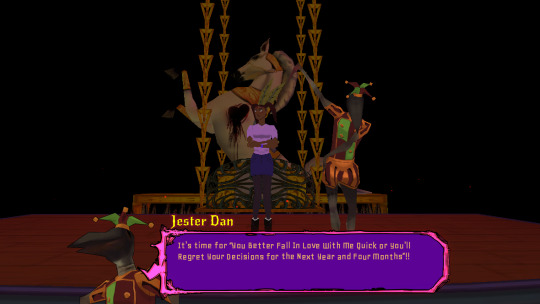
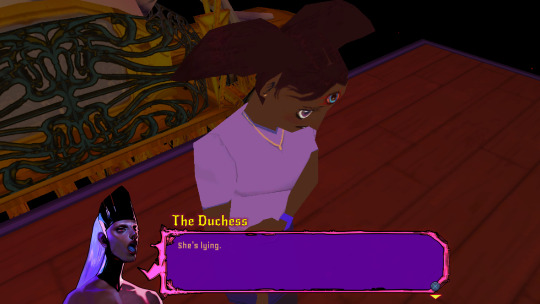
In the scene where we watch the duchess execute a woman for lying about her 'love' for the Duchess to save her life, there is a carousel-style horse in the background.
This is, I believe, the first time we see this horse carousel, and it appears with a bleeding heart. An empty spot where there used to be something. Love is not here.
The Duchesses room.
On the outside, you see paintings of Dream Eater and Chamuel.
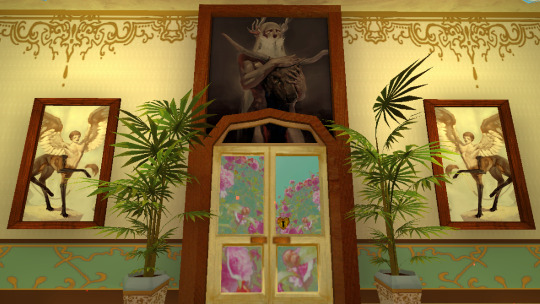
I used to think a lot of the paintings around the game were random - like maybe they were just filler. There's a lot of repetition of the same images over and over again, but I've come to understand it is its own visual language.
The Duchess seems to place a big focus on these two around the hotel - who are "quite infamous" in the supernatural community. There's the obvious connection to taboo love here, but I think it's also an example of a demon being able to resist the change of love. Which might explain the hierarchy here of Dream Eater being on the top/larger. More value is placed on Dream Eater, who holds onto the past.
[Spoilers for inside the Duchesses room]


Straight off the bat, you start to notice a trend in this room. This is where I started picking up on the meanings behind certain pieces and noticing the emphasis on horses throughout the game, especially in regards to the Duchess. It might feel like maybe they just like horses - having a picture book with horses or framed paintings all over their room seems like more of an interest, but it continues to entwine them in the language of love.
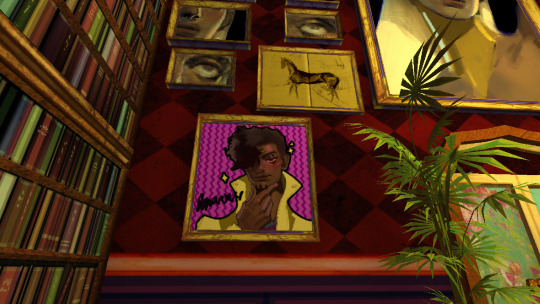
Also - I won't go into this too deeply but the repetitive paintings of the Duchess, especially the close ups of their eye/features, is a parallel to the fractured, disjointed images of Chamuels face that represent his 'mortalisation' and get more and more frequent (and also, violent) the further he gets into his struggle with love. It implies to me that the Duchess has already begun this process, or at least reflects how they've been fractured by love as well.
Ironically, the picture of the lead singer of Michelle's favourite band, who they brought to the hotel to make her feel more at home is right next to it. It's not mentioned if the Duchess was already a fan, or if they checked it out because of Michelle/how much they love her outfit (fish fight shirt included!) :)
Here we see the horse with the bleeding heart again.
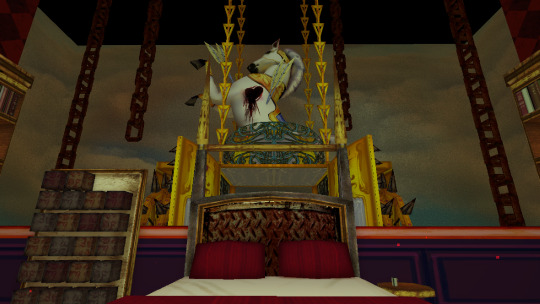
Over their clean, neat bed which is kind of a mix between elegant hotel opulence and rusty torture chamber imagery (the case on the left side of the bed..... if you know you know). Their room itself is a beautiful illusion that seeks to cover up for their one weakness, but it still shows through.
You also find some assorted Duchess-themed artifacts.

Notably, the missing heart fragment. T.A.D says this is "said to be what remains of the Duchesses heart after the incident."
(There's also the presence of Dying Petals in the Duchesses room, but that's a topic for another post.)
I also find it interesting that they has these on their shelf. A visual reference to Dream Eater fighting himself, maybe?
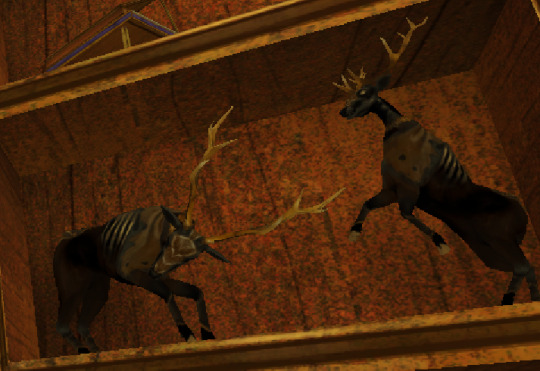
[Also, Bonus A La Mode games reference. Or, the Duchesses version of the warriors that I've just now realised is a reference to the devs logo]

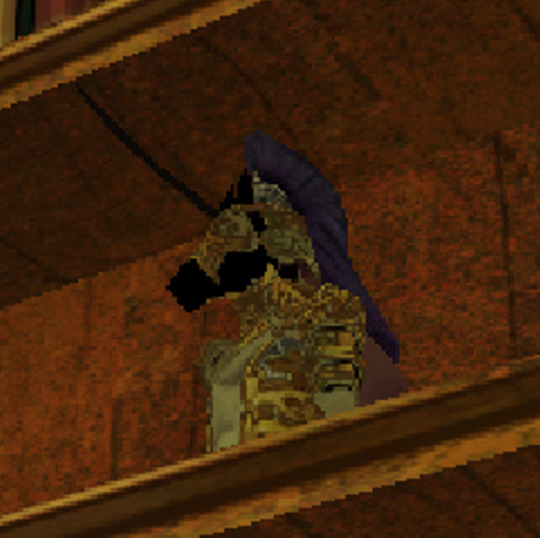
Hotel Ascent is when things start to get more... surreal.
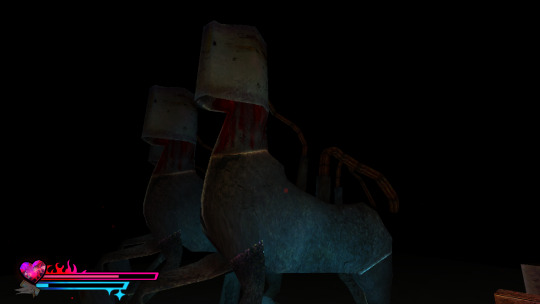
There's a repeated trial throughout this area where, to pass to the next room, you have to charge your heartbreaker before shooting the heart of the horse statue. The first instance of this is also accompanied by a literal anatomical heart you have to shoot to charge it up.

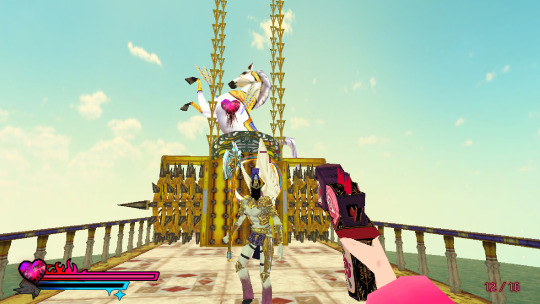
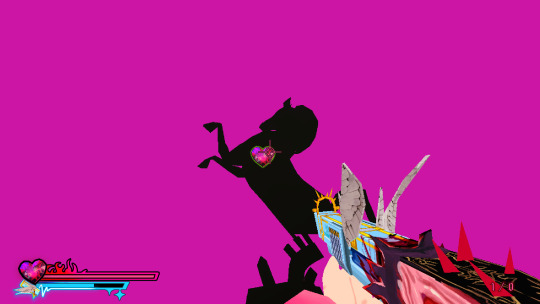
Usually, it's aggressively defended by giant roller-spikes and/or enemy hordes. The Duchess doesn't want you to break past their barriers and into their heart, that's for sure.
This is the opening scene for the final boss fight.


The statues stay in the background for the whole fight. Notice how these ones no longer have arrows jutting from their chests.
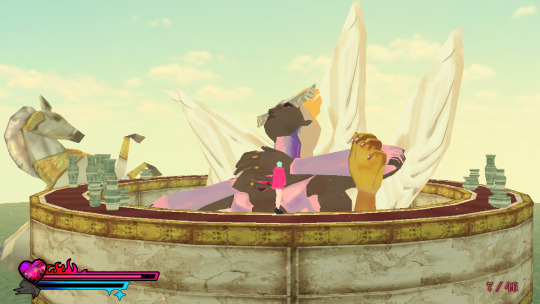
(We also see these weird abstract horses from the start of hotel ascent again - even they have a true form which can only be seen with the third eye.)
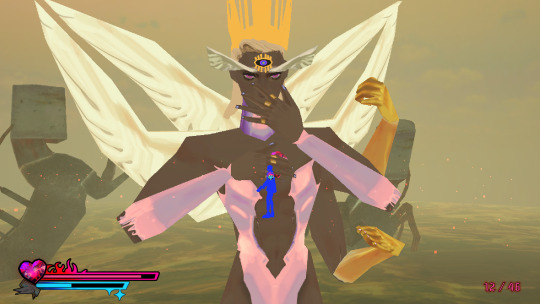
Other uses in the game.
I think Dream Eater's Palace would take up wayy too much, so I'll skip it. It's already something that is canonically brought to attention in-game so Iif you've played it of course you'll already know how obsessed this guy is with, uh, horses, and what that says about him. :)
There is also a picture of Dream Eater (a.k.a "a forlorn being") in the church where Benedict and Robyn (the OTHER angel/demon relationship) spend most of their time together. You can imagine it's not on the side Beloved chooses to hang around haha.
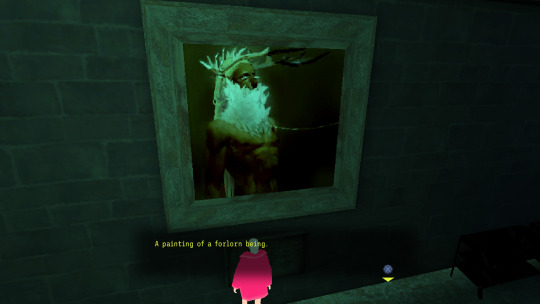
Oakley doesn't have anything in his diner as far as I know, but Darrel does have two paintings of the earlier picture of Duchess riding a horse in his bar.

He has other Duchess paintings also, likely because they're his boss, but this feels very in-place in the bar for a reason.
It does mean that all three relationships in the game have some connection to Dream Eater/Chamuel imagery. Some of it may be coincidence, but I thought I'd mention this anyway as it solidifies the connection to love.
Okay fine I'll talk about the crypt.
The examples/relationships I've used here are romantic in nature, but it's worth noting there are excessive amount of Chamuel statues in the crypt as well. A crypt that belonged to a broken family, that has mostly covered up it's traces of said family after Gabriella took revenge on her parents. Traces of angels are systematically replaced with demonic imagery, as though Gabriella was insulted by the appearance of love being featured so heavily throughout her families tomb. You might see love in the past (using your third eye), but it's disappeared/fractured.
So what's up with the horses?
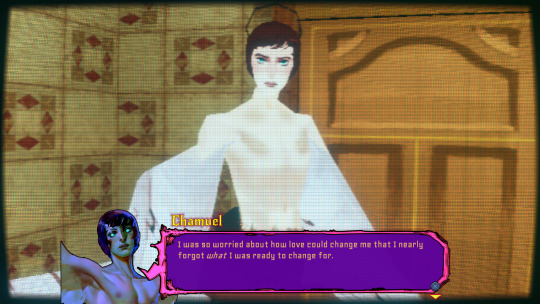
I already kind of mentioned this at the start, but in this fictional world the concept of love and horses are pretty much inherently linked through Chamuel, so I appreciate how they leaned into this by making it sort of a cultural concept of love.
Horses can be seen as a symbol of love historically, but generally the cultural zeitgeist uses something a bit more fragile and delicate, like doves or rabbits.
It reminds me of Disco Elysium, where love is understood through the lungs rather than the heart due to it's association with Dolores Dei; a pseudo-religious symbol who was just a deified historical figure. Changing what love 'looks' like in a way that serves the story. It shows how well-intergrated Dream Eater and Chamuel are in the world-building and story. They represent the fear of change, and the consequent leap of faith you need to embrace that change. Something the Duchess needs.
Why not use horses? It still feels childlike and nostalgic. They're strong, lively creatures who still exist as prey animals to be hunted - the Duchess doesn't want to be hunted. They want to hunt.
And, life didn't really go that way for them.
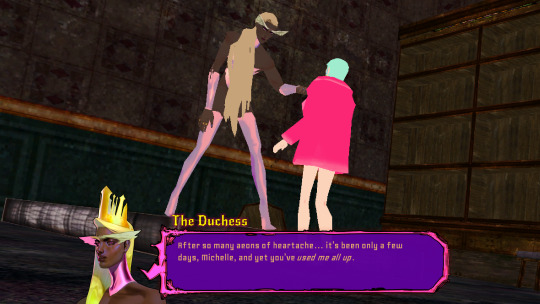
By the way I lied earlier, not every episode of Dying Petals has a horse painting. In the Duchess route, during the final episode when Epiphany and Canary break up, they are cramped into the only corner of the room that doesn't have horses. I guess Michelle really did move on from Leslie. :)
#sorry we're closed#sorry were closed#long post#meta#analysis#swc spoilers#not spoiler free#possibly even the most spoiler-infested swc post on tumblr so far#read at your own risk#the duchess swc#michelle swc#dream eater swc#chamuel swc#swc analysis#i might have missed stuff and theres a lot ive left out intentionally but#this has been running around in the back of my mind for a whole week so#yeehaw! so to speak#if anyone else has stuff to add please do. please talk to me about this game
196 notes
·
View notes
Text
If TWEoS doesn't have the senti stuff what's stopping me from making the tibet trip a vanity project. What's stopping me from having Emilie and Gabriel fly out to Qamdo in the fall of 1989 with a team of archeologists led by some poor undergraduate who just happened to be one of the only researchers in the world with a speciality in arcane artifacts that are barely even more than legend—
Emilie takes every opportunity to pose near almost anything she finds particularly "exotic", the way she drapes her hand over the baby bump on her stomach already practiced to perfection. Gabriel is collecting every swatch of fabric he can, looking for patterns to copy and iconography to borrow all for a new fashion line: the fashion line that is, in all truth, an alibi. In his head, he's already planning to force the team that's no doubt scouring the mountains into NDAs before they can leave the country—No, kill them if he can. Mlle. Sancoeur all but confirmed his suspicions that what they're looking to bring him are sources of almost limitless power. Nobody that he hasn't given explicit permission to know shall know of it.
Free Tibet gets lip service in the February 1990 Haute Couture exhibition. Emilie models a dress embroidered with pairs of golden fish, but the way she walks makes it obvious that she's truly showing off her 8 months of pregnancy.
#uh. sorry this might be incomprehensible#this is fun though I love hacking out lore. ...unless I change it soon but ermm hopefully not#tweos lore
78 notes
·
View notes
Text
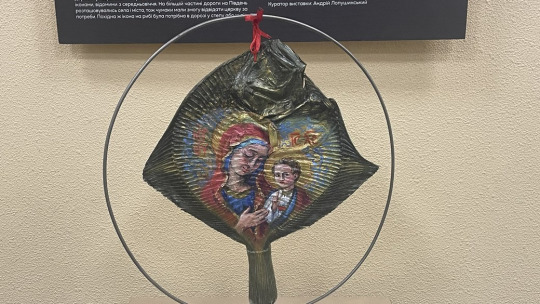
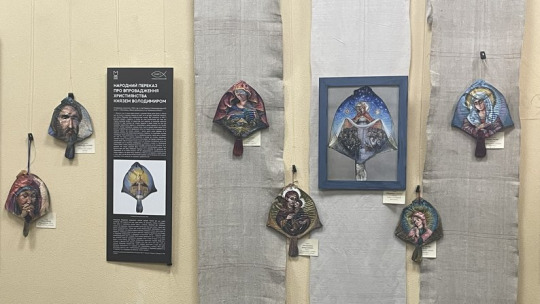
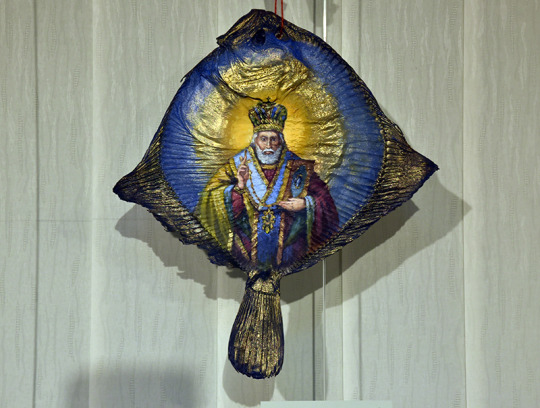
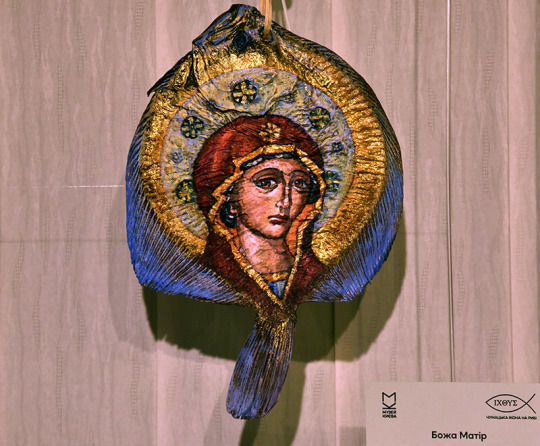
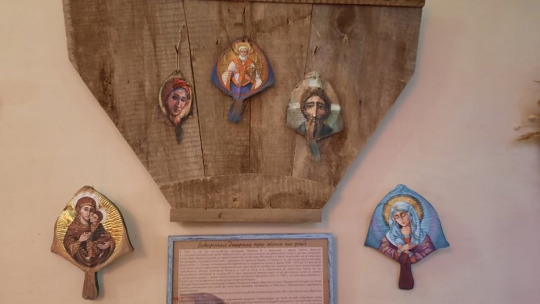
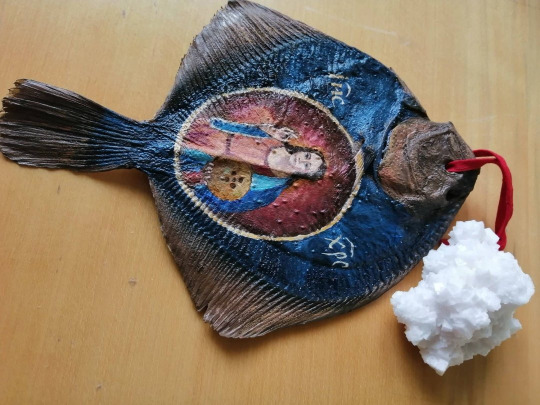
Because people seemed to like the original post so much, here are some more examples of chumak iconography.
Iconography on dried fish began to be painted in the 19th century by Ukrainian fish and salt merchants, called “chumaks”. They brought their goods from the Black and Azov Seas using carts pulled by oxen, and then sold them at street markets. Chumaks spent a lot of time on the road. They attached such images to their carts, probably as travel icons, in the same way as some modern Christians place icons in their cars It is possible that chumaks chose fish as the material for their icons not by chance, since the fish is one of the oldest Christian symbols. In Greek, ichthys is an acronym meaning “Jesus Christ, Son of God, Saviour”. It is also possible that the traditional wooden base was much more expensive than dried fish and quickly deteriorated under the influence of sun and precipitation
420 notes
·
View notes
Text
Tessa Quinn Character Analysis
Just for fun, because Sleepless Domain is amazing. Spoilers, of course.
Tessa is a self-centered character. When I say this, I am by no means saying that she is a bad person or doesn't care about her friends. But she elevates her own importance again, and again, and again.
Look at her bedroom. Yes, she has her whole team represented up top. But the rest of her décor is her own merch. Nine Alchemical Aether figurines. A costume. A fan. A lunchbox. A trading card. A button. Another bag with Aether's sigil as the clasp. Aether-themed jewelry. Possibly more, if the abstracted pink and yellow posters represent Aether as well.

Compare this to Undine's room. Very little Magical Girl merchandise! Like Tessa, she has Team Alchemical represented in doll form. Unlike Tessa, she doesn't have herself as one standalone, let alone several. (Fascinatingly, we see an Alchemical Air poster - did Sylvia, in her self-promotional way, give this to Undine? Or did Undine purchase the poster because she knows that Sylvia's Magical Girl earnings make up her family's income?)


Undine also has her friends represented in pre-Magical Girl form, in the photo on her mirror.

Now, let's look at Kokoro's room. Heartful Punch, like Alchemical Aether, is a super-powerful, popular, pink Magical Girl. You wouldn't know it from her bedroom, though. We've got some heart-shaped iconography, in the lamp. A Magical Girl poster for Team Forte - not Kokoro's team, but another team/band. The pink poster with the fist could easily be Heartful Punch merch, but it seems to be the only piece of self-promotional material, and a subtle example at that (semi-abstracted, without her face or name on it).


Undine and Kokoro's rooms are more about their interests than their Magical Girl identities. Kokoro has exercise equipment, cat things for Kicks, hair styling supplies. Undine has animal plushies, lots of books, her fish. Meanwhile, Tessa's room centers primarily around Alchemical Aether merch. She surrounds herself with her own image, and specifically with the Magical Girl version of her own image.
We know that, when Team Alchemical is alive, Tessa fixates on her status as their leader.

And, when Undine first gets her powers, Sylvia, Sally, and Gwen rush towards her with excitement for her -
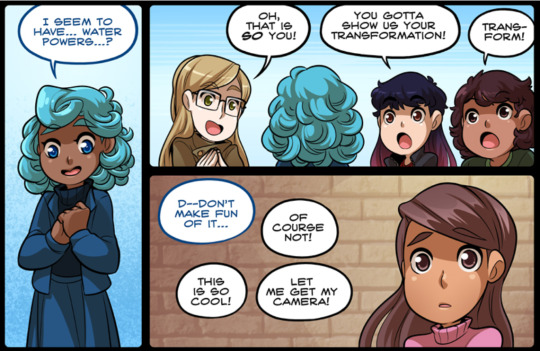
- while Tessa hangs back, a slightly crestfallen look on her face. I don't think it's a reach to believe that she is disappointed that she isn't the one who got powers. Interestingly, Undine herself seems a bit surprised that she gets powers before Tessa.

Undine's assumption that Gwen or Tessa would become a Magical Girl before herself suggests that there is a dynamic among the friends, even before they are a Magical Girl team, in which some of the girls assume more significance within the group. Tessa is one of them. Further, while interstitial guest comics may not be canon, Undine finds her dream self standing on a very interesting mural.

Alchemical Aether dominates this scene. The other four girls are represented by their faces, enclosed in pink circles. Aether's full body looms serenely over them, hands clasped. Her sigil surrounds the whole tableau. In Undine's subconscious, Tessa has a literally outsized presence in relation to the rest of the team. Of course, this comes from Undine's mind, and not Tessa's. But we have reason to believe that Tessa sees herself this way as well…

Tessa's Dream, or, as Goops calls it, "a memory that should have been [Tessa's] all along." Is Goops an unbiased source? Absolutely not. But I believe that this sequence is indeed Tessa's Dream, up until the point that her hair and speech turn a Goops shade of purple and Goops crows, "Now you're starting to incorporate my memories." If you accept that this is indeed Tessa's Dream as it happened, these panels are chock full of things to unpack about her self-image. First, we find her in a palanquin, carried by her faceless friends. She wears royal adornment - a robe, a crown, a scepter.
Now, Tessa is surprised and alarmed to find herself in this position in relation to her friends. She shakes off the robe, she tells them that they don't have to carry her.

And they listen. When Undine turns to face Tessa, she is Alchemical Water. She thanks Tessa, and then all of the girls drop the palanquin and run off as Magical Girls. Tessa's crown falls off.

She calls for them to wait, but they do not. The curtain closes and she is alone.

In Tessa's subconscious, she finds herself above her friends, both literally as they lift her and figuratively as she wears the trappings of royalty while they wear plain white. Undine thanks Tessa before she lets go, suggesting that Tessa granted her permission. Critically, it is when the girls become magical that they leave her. There is a before, in which Tessa is the center of their friendship, and an after, in which they become new people, drop her, stop listening to her and leave her… she has been robbed of her crown, her status, because now they have something in common that she does not.
While Tessa is embarrassed by the display and tries to put a stop to it - she would never actually dress as a queen and ask her friends to carry her on their backs - the fact that her Dream manifests this scenario suggests that in Tessa's subconscious, she believes herself to be the center of their pre-Magical Girl friendship, and to have no place within their Magical Girl one without powers of her own. Again, I don't believe Tessa is a bad person. I believe she is sincere when she tells the Woman in White that she wants to use her own powers to help her friends.
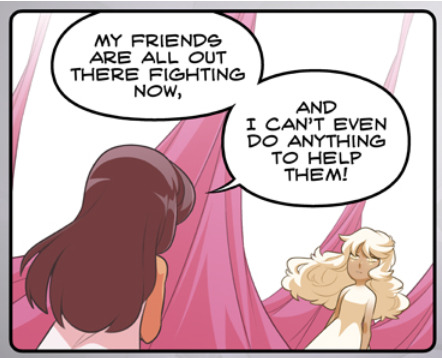
That said, she presumes that her friends need her to help them. That presumption leads all the way up to that fateful, fatal night, when she holds back from patrol with the belief that the other girls will struggle without her and appreciate her more as their leader.

(They die without her, of course. But they die because Goops murders them, not in the course of a normal patrol. Aether obliterates the monster when she arrives, but only can because she arrives afterwards… that fall would have killed her, too.)
Tessa would hate to see herself as the queen of her friends. Yet, she has no trouble asserting that she is their leader, believes herself indispensable to them, and cannot handle them having something she does not.
Even her assertion to Undine and the way she takes the blame stems from the fact that she believes herself to be responsible for all of them.
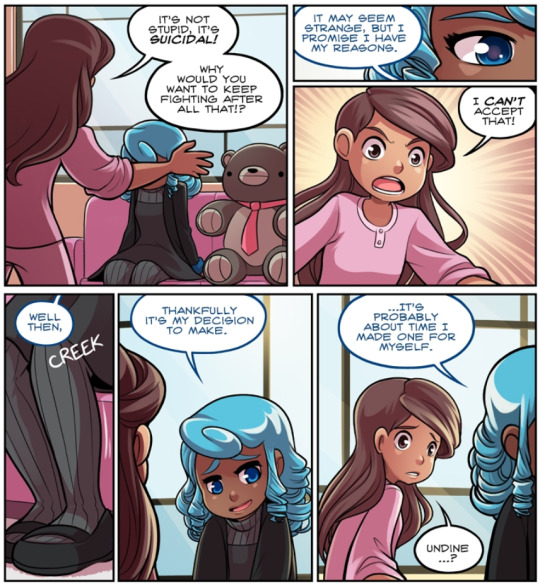
That's why she's so vulnerable to Goops. She can easily be convinced that the situation is all about her.

Ironically, Tessa's self-absorption does not indicate high self-esteem. Quite the opposite - Tessa is deeply insecure. She feels upset when her friends get powers before her not only out of jealousy, but also out of fear that they will leave her behind. She believes that she has no value to them without powers. Thus, she pins everything on being magical, powerful, the leader. Being Aether. Goops perceives this, and tries to tempt her with the promise of more power…

And taunts her with the loss of her identity as Aether.
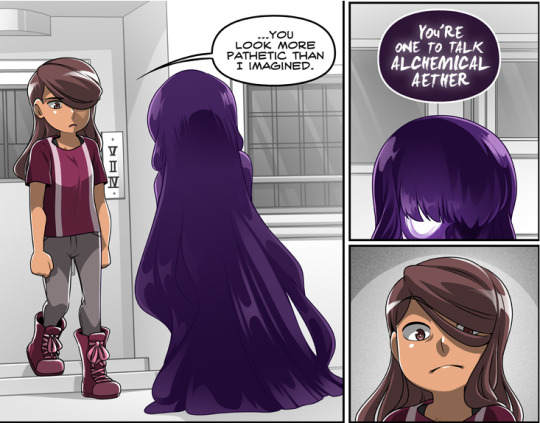
But by this point, Tessa has given up. Her self-absorption has devolved into self-loathing. She goes out to Goops with the intention of being killed.
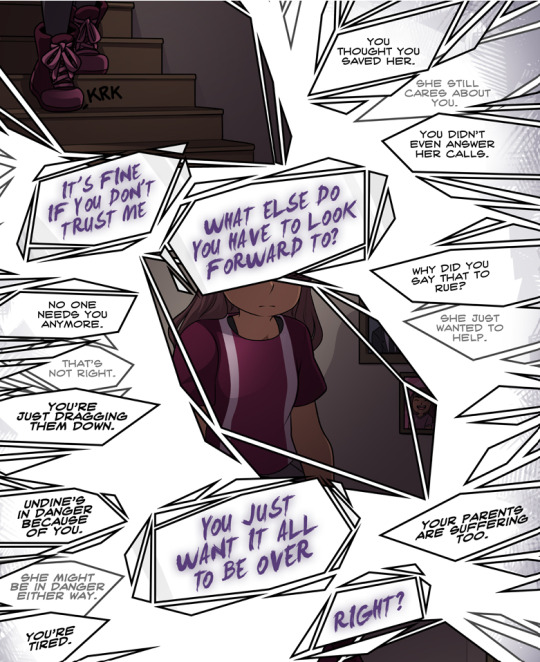
The text in gray, the vestiges of Tessa's self-worth, are weaker than her self-blame. Tessa is overwhelmed by what she perceives as her failure - to save Undine, to be friends with Rue, to be a good daughter. "No one needs you anymore," she thinks. And if she cannot be needed, then what's the point of living at all?
And then there's TessaGoops. Is Tessa her puppet, or are they truly fused into one person? I'm still not sure. I suppose time will tell.
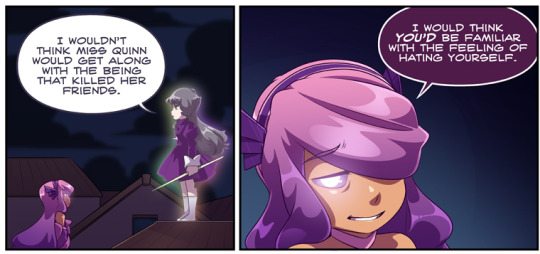
At the very least, I believe Aether's powers are still present, somehow, at least slightly. Why else would the spot where her sigil was glow when Undine approached?

I suspect it will matter, at some point, that Alchemical Water has a little bit of Alchemical Aether inside her.

We shall see!
#sleepless domain#tessa quinn#alchemical aether#alchemical water#undine wells#heartful punch#kokoro aichi#goops#the purple one#the golden one#the woman in white#team alchemical#edited slightly bc I got outrageous lime mixed up with forte drums#so the poster kokoro has is not her ex but just another team
92 notes
·
View notes
Text
Us as Chalchiuhtlicue
Chalchiuhtlicue, "Jade Skirt", is the goddess of lakes, rivers, and the sea. She's known for being the second wife of the rain god Tlaloc, and she's most commonly the Fourth Sun in the five sun legend.
Chalchiutlicue will often be depicted sitting on a throne with a stream of water flowing from her skirt.
Now, water looks like this in some Aztec codices. These are taken from Codex Mendoza, I was able to find these and the glyphs further down this post in the Visual Lexicon of Aztec Hieroglyphs online!

So water is parted like this, and it has these circle and tear-drop shaped shells on each end.
Here are some representations of Chalchiuhtlicue with water illustrated in the same way. Note that she also tends to have people swimming in there, and other objects.
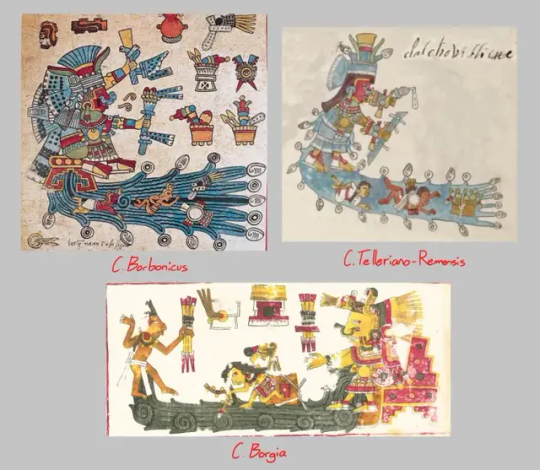
I thought the strands of water looked similar to Us' tentacles from their bioship. They also use these tentacles to hold the others' ships in ep3, much like Chalchiuhtlicue has people inside her streams of water.
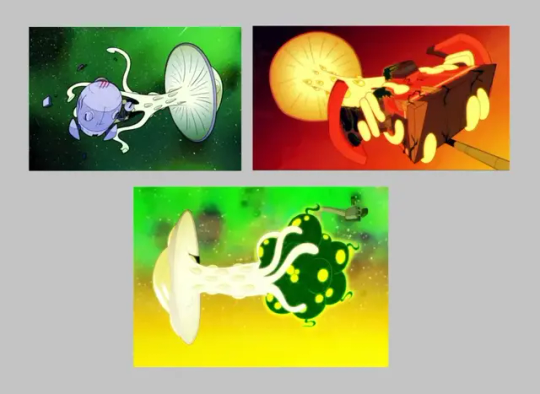
The way their limbs look in their physical form resembles the way the goddess' water flows, too
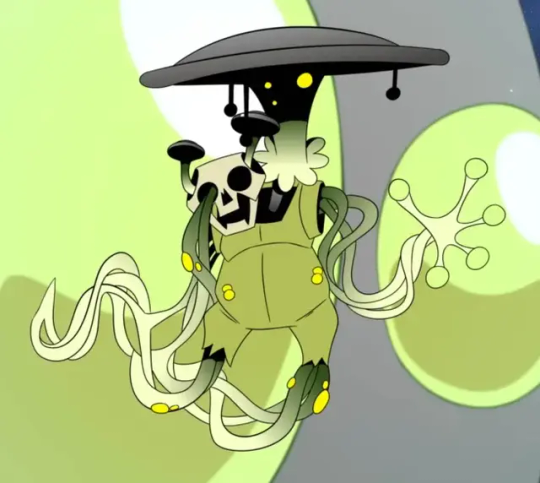
Another reference to water could be the design of Beebs' guitar. It has an ocean wave on it.
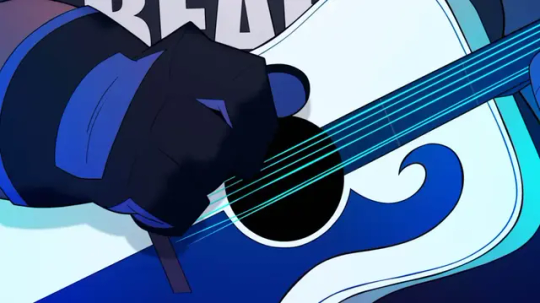
Beebs' god is Xipe Totec, and as far as I know he has no relation to the sea or water, but Us' does! The guitar belongs to Beebs, yes, but it's the fact that he uses it to communicate with Us, and the instrument becomes associated with Us, that it makes me think it's a reference to Chalchiuhtlicue, since she is the goddess of bodies of water.
Speaking of, in Beebs' post I said his guitar could be a reference to Xipe's rattlestaff, the chicahuaztli. This is an object that both Xipe and Chalchiuhtlicue can be seen carrying, along with a couple other gods.
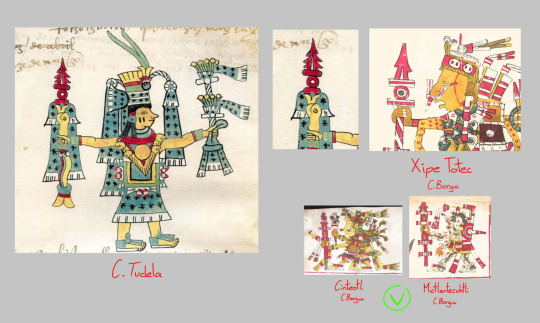
Us makes a certain sound in Scratch's flashback, like that of a rattle (21:00) But it might be me going crazy.
I also considered Them to be designed to resemble a chicahuaztli, but that is a stretch, too.
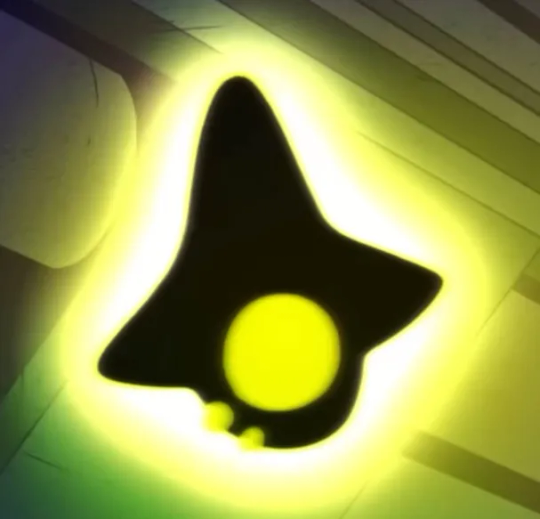

Another important element of Chalchiuhtlicue's iconography is that she has a pair of tassels on the sides of her head, and her dress is also adorned with small tassels. This can be seen in codices as well as in statues of her.
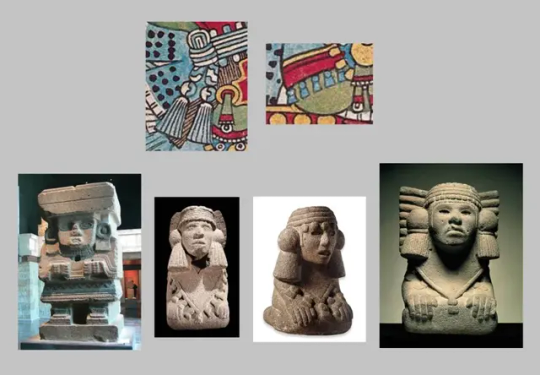
Us has these drops of a black liquid beneath their cap, hanging by on the sides of their head. This is because they're based on an actual mushroom, the inky cap mushroom!


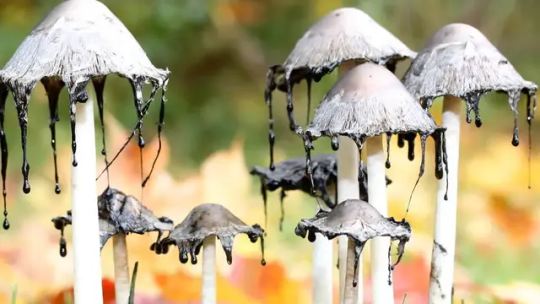
These drops could be a reference to the tassels perhaps?
—
Next I wanna talk about this symbol on the cap of Us' bioship
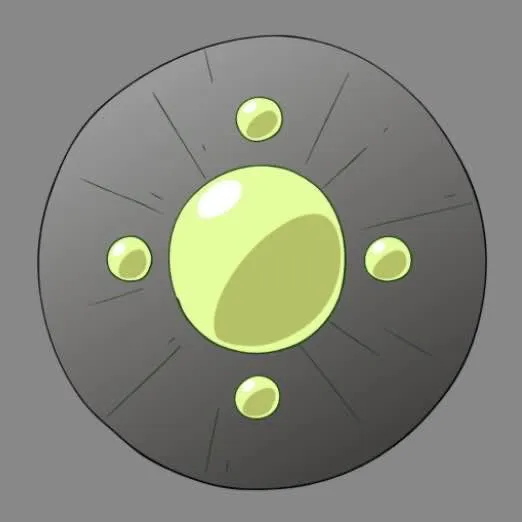
This is an example of a quincunx, it's a geometric pattern consisting of five elements: four of them form a square, and the fifth one is placed in the middle.
Symbols like this one appear in monkey wrench, from subtle places like the dice in the casino
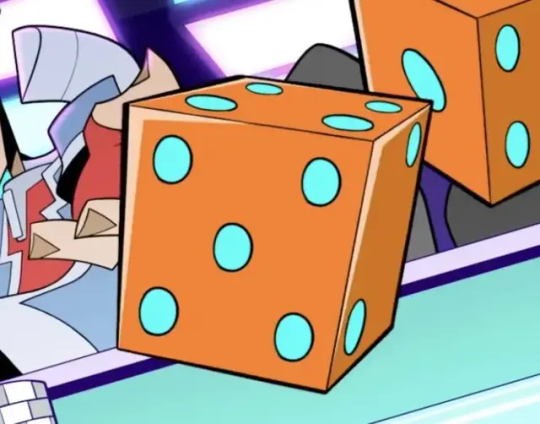
To the decorations in the bar and the restaurant, as well as the inside of Beebs' arm!

Why am I bringing this up? The Mexica used the quincunx a lot, in a variety of ways, but also with circles like we see in the show, so we're gonna focus on those here

They also used very similar circles for a couple of glyphs, such as these

I wanna bring attention to that fourth one. Chalchiuhtlicue's name consists of two words: chalchihuitl, "jade", and cueitl, "skirt". The symbol for jade looks the most similar to Us' eyes, with the texture of a jade in the middle.



—
Lastly there is one more thing that Us and Chalchiuhtlicue have in common, thematically.
In the Legend Of The Suns, Chalchiuhtlicue is the Fourth Sun (although other versions exist). The way that her era ended was that Tezcatlipoca accused her of faking her love for humans to get praise. She cried for hundreds of years, flooding the whole world, and the humans that lived there turned into fish.
Us is the first and so far the only character to cry in the series, in a non-comical way. It's in this scene that the show takes a more serious tone.
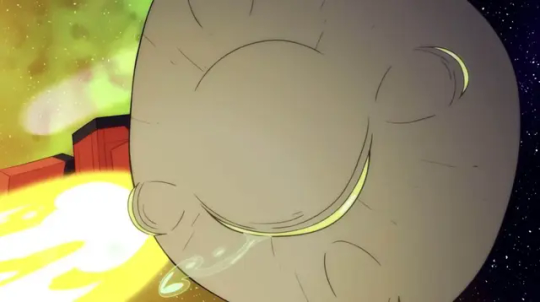
Us is, arguably, a somber and sad character, especially after the loss of Them. Both Us and the goddess also seem to have strong reactions to their circumstances, seeing how Us was willing to join Them when they accepted that there was no help for their friend.
It is also worth mentioning that their bioship and their phantom form move like a jellyfish, like a sea creature.
List
#americans are asleep post five sun theory ‼️#monkey wrench#monkey wrench theory#five sun theory#agari us#aztec mythology#chalchiuhtlicue#you know what that means! FISH
29 notes
·
View notes
Text
#MetalMonday :



Akan weights in the form of mudfish
Ghana / Côte d'Ivoire, 18-19th c.
Copper alloy
On display at National Museum of African Art, Smithsonian Institution
Symbols of: wealth, power, transformation, resilience
Copper alloy
“Visually, [Akan] weights fall into two distinct categories: geometric and figurative. Stylistically they are divided into early (c. 1400-1700) and late (c. 1700-1900) periods. During the late period, figurative weights increased in both number and variety, although geometric weights were still made. Generally, late-period figurative weights have added details and textures beyond the basic form that would identify the subject.”
“Some weights’ forms were selected just for their beauty or to display the owner’s status. Many, however, evoke Akan proverbs, whose meanings vary with time and place—more than one interpretation can apply. Hence water creatures were popular weights, with their associations of fluidity, flexibility, and movement between worlds.”
“Th[ese] weight[s] [are] in the form of mudfish, a symbol of wealth and transformation. The mudfish lives when ordinary animals would die, surviving the loss of water.”
(Info via NMAA)
#animals in art#19th century art#museum visit#18th century art#Akan art#weight#metalwork#fish#mudfish#animal iconography#African art#West African art#Metal Monday#sculpture#figure#National Museum of African Art#copper
64 notes
·
View notes
Text
The Fish Theory
I'm Making this post so I can either be proven right or wrong when the DLC Comes out.
In Elden Ring, there's a suspicious hole in the story. That hole is perplexingly mermaid-shaped.

When Godwyn is found in game, something's happened to him. He's become gargantuan, twisted, stuck in the pose of his death and staring listlessly out into the darkness of the Deeproot Depths.
He's also a mermaid.
Why?
One could chock this up to a cool design decision, invoking the Ningen and the other aquatic imagery associated with Those Who Live In Death (Boats, Scales, Fins, Stagnation, Flies, etc). His head resembles a clam, and his hair is matted like it's wet. He has a tail, scaled and mermaid like. This could all just be a cool design.
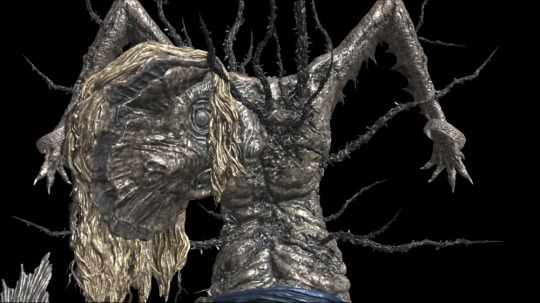
But Fromsoft, the ones who put staggering amounts of detail into random pieces of iconography, building techniques, and even the road tiling to denote who created it and why, are not one to toss something into a game for it to look cool.
There has to be a reason Godwyn looks like that.
I personally believe that Godwyn was always this fish monster, and never a regular Demigod.
My Evidence:
1: Godwyn's face is never shown.
"But there's paintings of most characters!"
Not Godwyn.
"But the Statue of him cradling Miquella and Malenia!"

There's no confirmation that this is Godwyn. it may very well be Messmer, given his relationship to fire, his descendancy of Marika and/or Radagon, and his neat fit into the Butterfly Theory (Miquella=Nascent, Malenia=Aeonian, Messmer=Smoldering). Again, no confirmation.
"But we see him in the Intro and the cinematic trailer!"
That I will give you, however there is precedence on how this could be subverted. In the shot of him dead:

His face is obscured by shadows and hair, purposefully keeping him anonymous. And yet, a power of the Golden Lineage, demonstrated by Morgott and Mohg, is to project versions of themselves elsewhere:

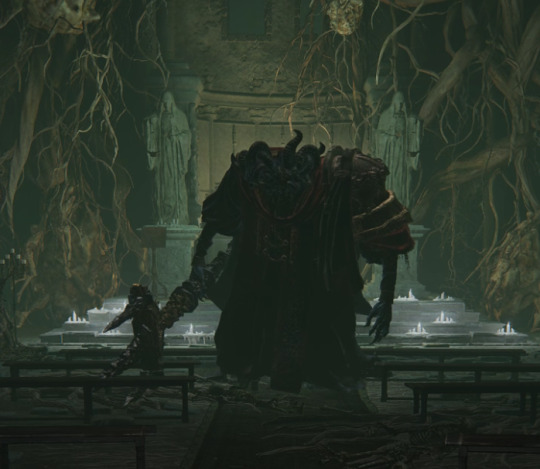
(Godfrey even displays this to a lesser extent, with the golden clone of him in Leyndell.)
I believe that images of Godwyn and his appearances in the Lands Between are projections of him.
In every shot of Godwyn, you never see his face fully or his legs at all. Both are obscured, and even the shot of his eye only shows the barest hints of skin, which could be the more alive version of his clam-head skin. His forearms, where the fins grow out of in his Prince-of-Death form, are even suspiciously covered up. The skin of the Prince-of-Death is even the same as the head, so no contradictions in skin color there.
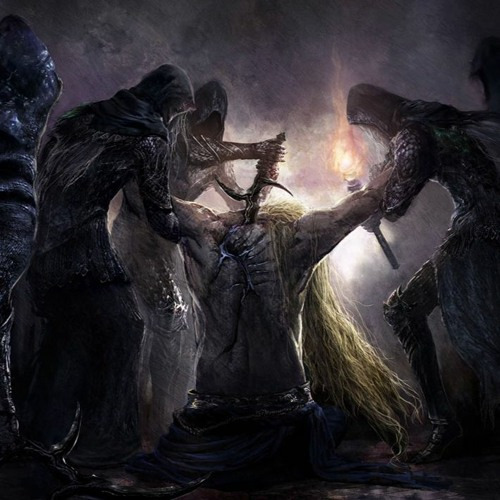
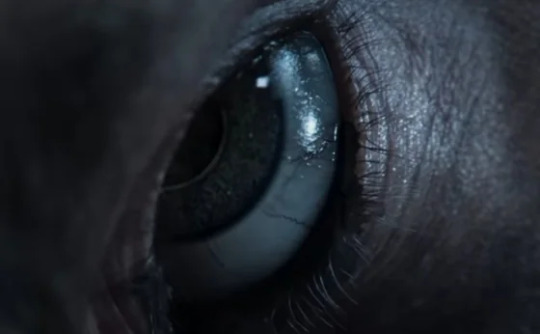
My final piece of evidence is this:
All of Queen Marika's children are cursed.
I'm talking specifically of Marika, and not the ones descended from Radagon taking charge. Morgott and Mohg are Omens. Miquella, Malenia, and Messmer are cursed or appear to possess unnatural features (Eternal youth, rot, serpentine characteristics). Ranni, Radahn, and Rykard appear perfectly fine.
So why does Godwyn appear normal, when none of his borthers or sisters do?
I think Godwyn was born as this mermaid-thing, or at least partially. He was born in the Age of Plenty, a time close to the Crucible, and may have inherited inhuman characteristics. But perhaps they were more easily covered-up, or perhaps he could project a version of himself that was more human, or maybe he simply wore a Mimic Veil.
This could explain his alliance with the Ancient Dragons, also creatures of the Crucible. It could explain why Deathroot confers aquatic features on those it effects, instead of the more avian features already associated with Death in the form of the Twinbird: Godwyn, already cursed, is the source of these appearences.
Godwyn doesn't look like that because of the Deathroot, Those Who Live In Death and those infected by Death look like that because of Godwyn.
#Completely crackpot theory (probably) but I just had to get this out#I feel the DLC will give us Death lore#elden ring#godwyn the golden#godwyn the prince of death#elden ring godwyn#rune of death#elden ring theory
84 notes
·
View notes
Photo

Raven Tales of the Athabaskan (Dene)-Speaking Peoples
The Raven tales are stories featuring the trickster figure Raven that come from the Athabaskan (Dene)-speaking peoples of the Pacific Northwest and other First Nations of the region of modern-day Canada. Raven, like the trickster figures of other Native peoples of North America, is depicted in these stories as a supernatural entity who may be a wise man or a fool.
North American Raven
Christian O. Petersen (CC BY-SA)
According to the lore of some First Nations, Raven is the creator god who made all things as they are. Scholar Larry J. Zimmerman comments:
As a creator, Raven made the world twice over. The first world was a paradise: meat was plentiful, and rivers flowed in both directions, so people never had to paddle their canoes. But Raven thought this world too easy for humans, and so he remade it in its familiar form, with all its hardships and woes.
(190)
The Athabaskan (Dene)-speaking peoples – which include the Aleuts, Inuit, Haida, Tahltan, Tlingit, Tsimshian, among many others – recognize the spiritual power of Raven and include his image in iconography such as seen on the traditional 'totem pole' which is still crafted in keeping with the traditions of the people.
The legend Raven's Great Adventure features the main character as a playful trickster and also explains why the image of Raven on totem poles has no beak. Raven and His Grandmother presents the figure's more selfish and vindictive aspect.
As with the trickster figures of other nations – featured in the Glooscap tales of the Wabanaki Confederacy, Manabozho tales of the Ojibwe and other Algonquin peoples, Coyote tales of the Shasta nation, Saynday tales of the Kiowa, or any others – Raven is an unpredictable character who may bring good fortune or bad luck but, either way, stands as a symbol of transformation and offers an audience the opportunity to learn from his, often, bad behavior and change their own.
The Raven Flood Totem, Alaska
Sir Henry Wellcome Collection (Public Domain)
Text
The following is taken from Voices of the Winds: Native American Legends by Margot Edmonds and Ella Clark. The introduction to Raven's Great Adventure is given by them:
Raven's Great Adventure
Early North American Indians living along the Alaska and North Pacific coast carved the stories of their people on trees, as they had no written language.
They carved strange and beautiful figures, representing people, animals, birds, fish, and supernatural characters, then painted them with bright colors. The tallest red cedar trees were selected for totem poles and are used for landmarks as well as illustrating the legends told from generation to generation.
On one of these poles was carved a stunning Raven, but he had no beak!
The Raven in Alaska was no ordinary bird. He had remarkable powers and could change into whatever form he wished. He could change from a bird to a man, and could not only fly and walk, but could swim underwater as fast as any fish.
One day, Raven took the form of a little, bent-over old man to walk through a forest. He wore a long white beard and walked slowly. After a while, Raven felt hungry. As he thought about this, he came to the edge of the forest near a village on the beach. There, many people were fishing for halibut.
In a flash, Raven thought of a scheme. He dived into the sea and swam to the spot where the fishermen dangled their hooks. Raven gobbled their bait, swimming from one hook to another. Each time Raven stole bait, the fishermen felt a tug on their lines. When the lines were pulled in, there was neither fish nor bait.
But Raven worked his trick once too often. When Houskana, an expert fisherman, felt a tug, he jerked his line quickly, hooking something heavy. Raven's jaw had caught on the hook! While Houskana tugged on his line, Raven pulled in the opposite direction. Then Raven grabbed hold of some rocks at the bottom of the sea and called, "O rocks, please help me!" But the rocks paid no attention.
Because of his great pain, Raven said to his jaw, "Break off, O jaw, for I am too tired." His jaw obeyed, and it broke off.
Houskana pulled in his line immediately. On his hook was a man's jaw with a long white beard! It looked horrible enough to scare anyone. Houskana and the other fishermen were very frightened because they thought the jaw might belong to some evil spirit. They picked up their feet and ran as fast as they could to the chief's house.
Raven came out of the water and followed the fishermen. Though he was in great pain for lack of his jaw, no one noticed anything wrong because he covered the lower part of his face with his blanket.
The chief and the people examined the jaw that was hanging on the halibut hook. It was handed from one to another, and finally to Raven who said, "Oh, this is a wonder to behold!" as he threw back his blanket and replaced his jaw.
Raven performed his magic so quickly that no one had time to see what was happening. As soon as Raven's jaw was firmly in place again, he turned himself into a bird and flew out through the smoke hole of the chief's house. Only then did the people begin to realize it was the trickster Raven who had stolen their bait and been hooked on Houskana's fishing line.
On the totem pole, Raven was carved, not as the old man, but as himself without his beak, a reminder of how the old man lost his jaw.
Raven and His Grandmother
In her barrabara (a native home) at the end of a large village, lived an old grandmother with her grandson, a raven. The two lived apart from the other villagers because they were disliked. When the men returned from fishing for cod, the raven would come and beg for food, but they would never give him any of their catch. But when all had left the beach, the raven would come and pick up any leftover refuse, even sick fish. On these, raven and his grandmother lived.
One winter was extremely cold. Hunting was impossible; food became so scarce the villages neared starvation. Even their chief had but little left. So, the chief called all his people together and urged them to use every effort to obtain food enough for all, or they would starve.
The chief then announced that he wished for his son to take a bride and she would be selected from the girls of the village. All the girls responded to the excitement of the occasion and dressed in their very best costumes and jewelry.
For a short time, hunger was forgotten as the girls lined up for the contest and were judged by the critical eye of their chief, who selected the fairest of the fair for his son's bride. A feast was given by the chief following their marriage ceremony. But soon after hunger began again.
The raven perched on a pole outside his barrabara, observing and listening attentively to all that had happened. After the feast, he flew home and said to his grandmother, "I, too, want to marry." She made no reply, so he went about his work, gathering what food he could for his little home. Each day he flew to the beach and found dead fish or birds. He always gathered more than enough for two people. While he was in the village, he noted that the famine seemed worse. So, he asked the chief, "What will you give me, if I bring you food?"
The chief looked at him in great surprise and said, "You shall have my oldest daughter for your wife." Nothing could have pleased raven more. He flew away in a joyful mood and said to his grandmother, "Let's clean out the barrabara. Make everything clean for my bride. I am going to give the chief some food, and he has promised to give me his oldest daughter."
"Ai, Ai, Y-a-h! You are going to marry? Our barrabara is too small and too dirty. Where will you put your wife?"
"Caw! Caw! Caw! Never mind. Do as I say," he screamed at his grandmother, and began pecking her to hurry.
Early next morning raven flew away, and later in the day returned with a bundle of yukelah (dried salmon) in his talons. "Come with me to the chief's house, grandmother," he called to her. Raven handed the fish to the chief and received the chief's oldest daughter for his bride.
Raven preceded his grandmother as she brought the bride to their little home. He cleared out the barrabara of old straw and bedding When the two women arrived, they found the little home empty, and the grandmother began to scold him and said, "What are you doing? Why are you throwing out everything."
"I am cleaning house, as you can see," Raven curtly said.
When night came, raven spread wide one wing, and asked his bride to lie on it, and then covered her with the other wing. She spent a miserable night, as Raven's fish odor nearly smothered her. So she determined she would leave in the morning.
But by morning, she decided to stay and try to become accustomed to him. During the day she was cheerless and worried. When raven offered her food, she would not eat it. On the second night, raven invited her to lay her head on his chest and seek rest in his arms. Only after much persuasion did she comply with his wish. The second night was no better for her, so early the next morning she stole away from him and went back to her father's house, telling him everything.
Upon waking and finding his wife gone, Raven inquired of his grandmother what she knew of his wife's whereabouts. She assured raven that she knew nothing. "Go then to the chief and bring her back to me," called raven. Grandmother feared him and left to do his bidding. When she came to the chief's house, she was pushed out of the door. This she promptly reported to her grandson.
The summer passed warm and pleasant, but a hard winter and another famine followed. As in the previous winter, the grandmother and the raven had plenty of food and wood, while others suffered greatly from lack of food. Raven's thoughts again turned to marriage. This time she was a young and beautiful girl who lived at the other end of the village. He told his grandmother about her and that he wanted to marry her. He asked, "Grandmother, will you go and bring the girl here, and I will marry her."
"Ai, Ai, Y-a-h! And you are going to marry her? Your first wife could not live with you because you smell strong. The girls do not wish to marry you."
"Caw! Caw! Caw! Never mind my smell! Never mind my smell! Go–do as I say."
To impress his commands and secure her obedience, he started pecking at her until she was glad to go. While his grandmother was gone, raven became restless and anxious. He hopped about the barrabara and nearby hillocks, straining his eyes for a sight of his expected bride.
Hurriedly he began cleaning out the barrabara, throwing out old straw, bedding, baskets, and all. The grandmother upon her return scolded Raven, but he paid no attention to her.
The young bride, like her predecessor, was enfolded tightly in his wings, and likewise she had a wretched and sleepless night. But she was determined to endure his odor if possible. She thought at least with him she would have plenty of food to eat. The second night was as bad as the first, but she stayed on and secretly concluded she would do her best to stay until spring.
On the third day the raven, seeing that his wife was still with him, said, "Grandmother, tomorrow I will go and get a big, fat whale. While I am gone, make a belt and a pair of torbarsars (native shoes) for my wife."
"Ai, Ai, Y-a-h! How will you bring a big, fat whale? The hunters cannot kill one, how will you do it?"
"Caw! Caw! Caw! Be quiet and do what I tell you: make the belt and torbarsars while I go and get the whale," he angrily exclaimed, using his most effective method of silencing her.
Before dawn next morning the raven flew away to sea. In his absence, the old woman was busily engaged making the things for the young bride, who watched and talked to her. About midday, they saw Raven flying toward shore, carrying a whale.
The grandmother started a big fire, and the young woman tucked up her parka (native dress), belted it with her new belt, put on the new torbarsars, sharpened the stone knife, and went to the beach to meet her husband. As he drew near, he called, "Grandmother, go into the village and tell all the people that I have brought home a big, fat whale."
She ran as hard as she could and told the joyful news. The half- dead people suddenly became alive. Some sharpened their knives, others dressed in their best clothes. But most of them just ran as they were and with such knives as they had with them to the beach to see the whale.
His sudden importance was not lost on the raven, who hopped up and down the whale's back, viewing the scene of carnage, as the people gorged themselves on the whale.
Every few moments raven would take a pebble out of his bag, then after some thought put it back. When the chief and his relatives came near, Raven drove them away. They had to be content just watching the people enjoy their feasting and carrying off blubber to their homes. Later, in the village, the people did share with the chief.
The raven's first wife, the chief's daughter, had a son by him, a little raven. She had it in her arms at the beach and walked in front of raven, where he could notice her. "Here is your child, look at it," she called. But he ignored her. She called to him several times and continued to show him the baby. At last he said, "Come closer–nearer still." But when she could not stand his odor any longer, she left him without a word.
Death occurred as a result of the feast. Many of the people ate so much fat on the spot that they died soon after. The rest of the people had eaten so much and filled their barrabaras so full, that during the night they all suffocated. Of the entire village, only three were left–the raven, his new wife, and the grandmother. There they lived on as their descendants do to this day.
Continue reading...
37 notes
·
View notes
Text
DisneySea: (Part 5) Mythical Marina

youtube
For our fifth stop, we've come to Mythical Marina!
Here, guests find themselves flung back in time to Ancient Greece, when the country was still split into city-states and the mighty gods of Mount Olympus were still worshipped.
Making up the port of call is a seaside city-state on the coast of The Mediterranean Sea (drawing heavy inspiration from real-life city-states like Athens, Corinth and Sparta)
Travel along stone-paved pathways accompanied by olive and cypress trees, marble statues, and classic architecture of the Doric, Ionic, and Corinthian orders.
The centerpiece of this land is The Temple of Poseidon, a slightly-sized down replica of the real-life temple of the same name found in Cape Sounion.
https://www.dropbox.com/scl/fi/rc64vfugnxrfwc9n0345u/odysseus_by_montjart-daqibnn.jpg?rlkey=otcuas0hjfl4m15w5bc6atz9f&raw=1
This land offers two attractions for guests to experience, both of which based off the expansive lore of Greek mythology.
The first one is The Odyssey.
On this Audio-Animatronic ride, guests get the chance to experience the legendary poem by Homer.
Just like in the poem, the story sees the war hero Odysseus embarking on a voyage just after The Trojan War to his home Ithaca, where his wife Penelope and their son Telemachus are awaiting his return.
But little did he know that his voyage would be easier said than done.
As through his journey, Odysseus finds himself having to endure the wrath of the god of the sea himself, Poseidon, and facing the many hardships he's placed on his path.
This includes getting captured by Calypso (who wanted to make him her lover), braving through a massive storm casted by Poseidon himself, being tempted by the food of The Lotus Eaters, battling the cyclops Polyphemus, escaping the cannibal-like Laestrygonians, avoiding Circe and her army of pig-men, navigating through the depths of the underworld to meet with the blind prophet Tiresias, ignoring the luring song of the sirens, and fighting the sea monster and living whirlpool Scylla and Charybdis.

The second attraction is Journey of the Hippocampus.
On this indoor rollercoaster ride, guests can hope aboard cars modeled after the legendary sea creature the ride is named after.
Soon enough, guests find themselves zooming through the underwater world of The Mediterranean, encountering coral reefs, sunken ruins, shipwrecks, and even volcanic chasms.
In terms of dining, this land has one restaurant: The Olive Tree.
Set in a replica of an ancient Greek courtyard with a massive olive tree at the center of it, this restaurant serves dishes dating back to the days of Ancient Greece such as wine-dipped barley bread, teganites, Greek salad (made with lettuce, asparagus, cucumber, onion, olives, olive oil and vinegar), a cheese and olive platter (consisting of feta, kasseri, kefalograviera, manouri, graviera, and kefalotyri), figs, a nut mix (consisting of pistachios, walnuts, almonds, sesame and chestnuts), a Greek fruit salad (made with figs, pomegranates, apples, pears, cherries and grapes), roasted fish, fried fish skewers, roasted octopus, fried squid, lentil soups, pastilli, a choice of either honey-drizzled cheese, figs or olives, and a wide selection of wine to choose from.
For shopping, we have The Agora.
Named after and set in a replica of the ancient Greek marketplace of the same name, this establishment sells items such as Greek dolls, Greek Orthodox Iconography, leather goods, and evil eye charms.
There's also two smaller shops within this massive shop.
First there's Θησαυροί της Ελλάδας (“Treasures of Greece”), which sells Greek masks, carvings, statuettes, paintings, pottery, miniature mosaics and stories on scrolls, and Νέκταρ των Θεών (“Nectar of the Gods”), which sells food items, like Kalamata olives, olive oil, and traditional Greek spices.
As for entertainment, there's The Players of Dionysus.
Based in a replica of an ancient Greek theater, this group performs somewhat condensed versions of classic Greek theater productions such as Medea, Oedipus Rex, The Frogs, and even Disney's very own adaptation of Hercules.
And finally for character greetings, we have Hercules, Pegasus, Philoctetes, Megara, Hades, Zeus and Hermes.
#theme park idea#theme park ideas#theme park concept#theme park design#tokyo disneysea#disneysea#walt disney imagineering#disney parks#greece#ancient greece#greek mythology#the odyssey#hippocampus#hercules
10 notes
·
View notes